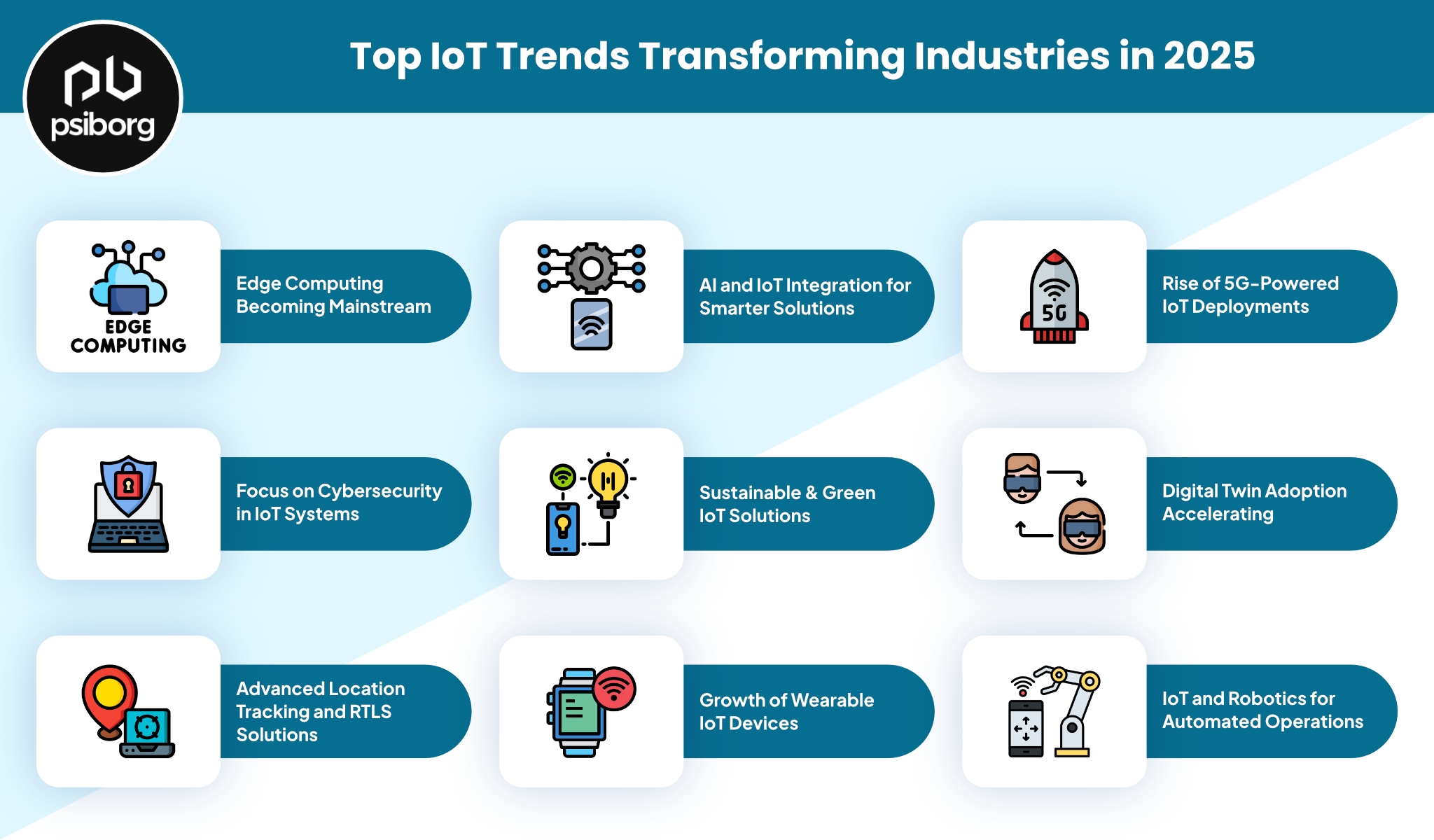The Internet of Things (IoT) is no longer just a technological buzzword – it is a strategic enabler for businesses worldwide. As we move further into 2025, IoT is reshaping industries with smarter solutions, enhanced automation, and data-driven decisions. From manufacturing and healthcare to logistics and smart cities, emerging IoT trends are redefining operations, efficiency, and customer experiences. This blog explores the top IoT trends transforming industries in 2025 and how organisations can leverage them for sustainable growth.

1. Edge Computing Becoming Mainstream
What is Edge Computing in IoT?
Edge computing refers to processing data closer to the source (device or sensor) rather than sending it to a central cloud. In IoT, this reduces latency, enhances speed, and ensures real-time decision-making.
Why is it Trending in 2025?
With the exponential growth of connected devices, bandwidth constraints and latency issues are becoming critical. Edge computing addresses these challenges by enabling local data processing. Industries such as manufacturing use edge gateways for instant defect detection on production lines, while logistics use them for quick route optimisation.
2. AI and IoT Integration for Smarter Solutions
AIoT: The Next Evolution
Artificial Intelligence combined with IoT – known as AIoT – is transforming connected systems into intelligent solutions. AI algorithms analyse massive IoT data streams to derive actionable insights, automate decisions, and predict anomalies.
Industry Applications:
Manufacturing: Predictive maintenance of machines using AI models analysing sensor data.
Healthcare: AI-driven patient monitoring systems for early diagnosis.
Retail: Smart shelves with AI analytics for inventory management and customer behaviour analysis.
3. Rise of 5G-Powered IoT Deployments
5G + IoT: Enabling Ultra-Low Latency
The rollout of 5G networks is revolutionising IoT applications requiring real-time communication. Its high bandwidth and ultra-low latency make it ideal for mission-critical use cases.
Impact on Industries:
Smart Cities: Faster communication between sensors for traffic management and public safety.
Healthcare: Real-time remote surgeries and telemedicine.
Industrial Automation: Seamless connectivity for autonomous robots and AGVs in factories.
4. Focus on Cybersecurity in IoT Systems
Why is IoT Security Critical?
With billions of devices connected, each endpoint is a potential vulnerability. In 2025, cybersecurity is a top priority for businesses adopting IoT to prevent data breaches and operational disruptions.
Key Trends in IoT Security:
Blockchain integration for secure data exchange.
AI-based threat detection to identify and mitigate anomalies.
Zero Trust security models ensuring strict authentication at every access point.
5. Sustainable and Green IoT Solutions
IoT Driving Environmental Responsibility
Sustainability is no longer optional. IoT solutions are enabling industries to reduce their carbon footprint, optimise resource usage, and achieve environmental compliance.
Examples Across Industries:
Smart Agriculture: Precision farming using IoT sensors for optimal water and fertiliser usage.
Smart Buildings: Energy management systems monitoring consumption and optimizing HVAC systems.
Manufacturing: Monitoring emissions and waste management using IoT-enabled environmental sensors.
6. Digital Twin Adoption Accelerating
What are Digital Twins?
Digital twins are virtual replicas of physical assets or processes, powered by IoT data streams. They enable simulation, monitoring, and performance optimisation in real time.
Use Cases in 2025:
Manufacturing: Real-time monitoring and predictive maintenance of equipment.
Healthcare: Digital replicas of patient organs for pre-surgical planning.
Smart Cities: Urban planning and infrastructure optimisation using city-scale digital twins.
7. Interoperability and Standardisation in IoT
The Need for Seamless Integration
As IoT ecosystems grow, interoperability among devices and platforms becomes critical. Standardisation ensures devices from different vendors can communicate seamlessly, enabling unified solutions.
Industry Impact:
Faster IoT deployments without vendor lock-in
Simplified integrations with existing enterprise systems
Scalable and flexible architectures for future expansion
8. Advanced Location Tracking and RTLS Solutions
RTLS Enhancing Operational Visibility
Real-Time Location Systems (RTLS) are gaining traction in 2025 for precise tracking of assets, personnel, and equipment within facilities.
Industry Applications:
Warehouses: Tracking forklifts, pallets, and trolleys to optimise workflows.
Healthcare: Monitoring critical medical equipment and patient movement.
Manufacturing: Locating tools and machinery for quick access and reduced downtime.
9. Growth of Wearable IoT Devices
Beyond Fitness Trackers
Wearable IoT devices are evolving beyond health and fitness to include industrial safety, employee monitoring, and AR/VR-enabled training solutions.
Key Applications:
Industrial safety helmets with sensors to detect hazardous gases.
Wearable tags for workforce location tracking in manufacturing plants.
Healthcare wearables monitoring vital parameters for chronic patients.
10. IoT and Robotics for Automated Operations
Connected Robots Driving Efficiency
Robotics integrated with IoT enables automated, precise, and flexible operations in manufacturing, logistics, and healthcare.
Examples:
Autonomous Mobile Robots (AMRs) in warehouses for goods movement.
Robotic arms with IoT-enabled condition monitoring.
Healthcare robots assisting in elderly care and routine hospital tasks.
Conclusion
The future of industries lies in leveraging these emerging IoT trends of 2025 to build smarter, efficient, and more sustainable operations. From edge computing and AIoT to 5G, digital twins, and RTLS, businesses must embrace these innovations to stay competitive. At PsiBorg Technologies, we help organisations harness the power of IoT with customised, secure, and scalable solutions tailored to their unique needs. Get ready to transform your business with IoT and be a part of the connected future.
